Despite the strides made in recent years surrounding remote sensing and environmental IoT technology, multiyear, year-round records of physical parameters in the US-Canada Laurentian Great Lakes are few and far between. Even more so, finding data on subsurface conditions throughout the water column is even rarer. Nevertheless, physical parameters like temperature and currents are part of the fundamental characteristics of the Great Lakes, meaning the data could impact and inform management strategies for state and local groups.
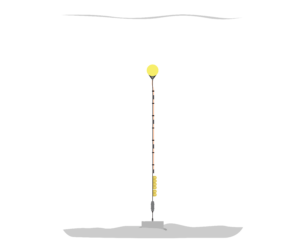
A subsurface mooring system with thermistor string attached (Credit: Emma Jones / Fondriest Environmental)
As stated in a 2022 data article published by ASLO, “Temperature structure is among the most fundamental characteristics of a lake, determining its mixing characteristics and ecosystem function and is the most direct mediator of climate change in lakes.”1,2,3,4 As a result, an International Joint Commission report highlights continuous and representative temperature measurement as a keystone for future monitoring and resource management.
Methods for Subsurface Temperature Monitoring
The focus of this study was primarily on temperature–however, some platforms gathered meteorological and/or convection data. The goal was to compile a comprehensive reference for temperature data in the US-Canada Laurentian Great Lakes. Three types of platforms were primarily used to house instrumentation to gather data: subsurface moorings, surface buoys, and WireWalkers.
“Subsurface moorings typically consist of a concrete anchor or pair of anchors, an acoustic release, flotation immediately above the release, a jacketed steel cable, and a steel subsurface float to keep the mooring taut and vertical.” Along the mooring line, thermistors are attached to gather data throughout the water column. To retrieve the device, the acoustic release is activated, and the mooring line floats to the top for retrieval.
Surface buoys are easier to deploy and retrieve data from, often containing a housed data logger that casts data remotely. The buoy system itself consists of a heavy anchor, a depressor weight, the buoy itself and a thermistor string. The buoys used in this data pool were deployed during the ice-free season and then replaced with a subsurface option during the ice season.
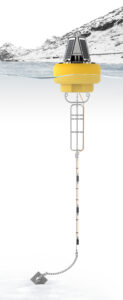
A NexSens 450 surface data buoy with thermistor strings attached (Credit: Emma Jones / Fondriest Environmental)
WireWalkers are a newer piece of technology that were deployed briefly (3 months) in 2017. This equipment was incorporated into the intensive 2017 summer program because WireWalkers are able to repeatedly profile the water column. WireWalkers use the surface wave field to operate a cam that allows an instrumented platform to repeatedly profile water levels that span the wireline. “A month-long deployment can consist of thousands of individual profiles.”1 More information on WireWalkers and how they work can be found here.
Conclusion
The resulting data compilation can be found at the links listed below. The intention of this report was not to draw conclusions but to gather valuable data for researchers to utilize when planning their seasonal management strategies. Overall, the data could have a wide range of implications and applications. Thus far, the article highlights the data pool’s role in exploring a plethora of physical phenomena. Applications include winter conditions, near-inertial oscillations, springtime convection, upwelling and others—ultimately, the range of impact for this research is endless.
Lake Superior Moored Temperature and Currents, Spring 2015 to Spring 2021
Lake Superior Moored Temperature and Currents, Sep 2005-May 2015
Sources
- Austin, J. and Elmer, C. 2022. An archive of Lake Superior temperature and current measurements, 2005–2020. Limnol. Oceanogr. Lett. https://doi.org/10.1002/lol2.10293
- Wetzel, R. G. 2001, Limnology: Lake and river ecosystems, 3rd Edition. Academic Press.
- Adrian, R., and others. 2009. Lakes as sentinels of climate change. Limnol. Oceanogr. 54: 2283–2297. doi:10.4319/lo. 2009.54.6_part_2.2283
- Williamson, C. E., J. E. Saros, W. F. Vincent, and J. P. Smol. 2009. Lakes and reservoirs as sentinels, integrators, and regulators of climate change. Limnol. Oceanogr. 54: 2273– 2282.




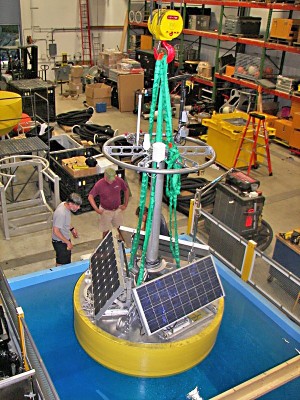
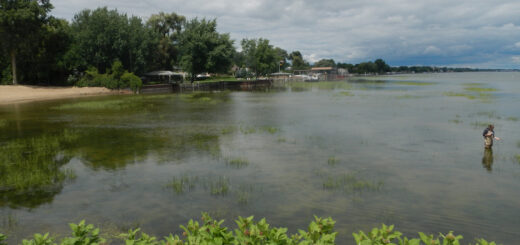
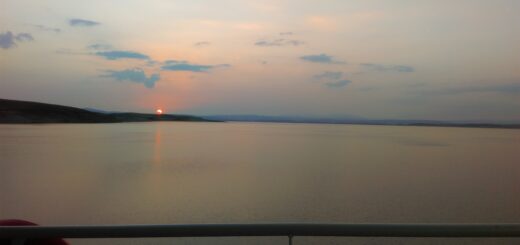
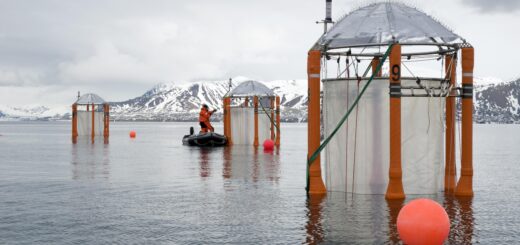
[…] water quality. Some rely on environmental IoT systems, manual sampling, controlled experiments, WireWalkers that sample the water column and many other monitoring devices to gather data consistently […]